June 8, 1977
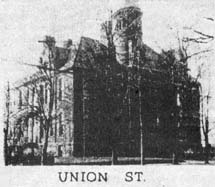
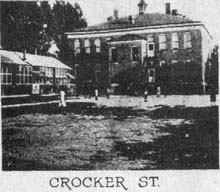
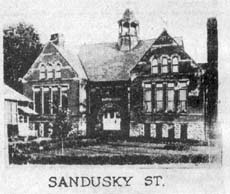
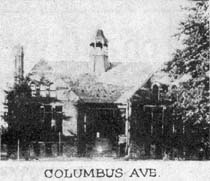
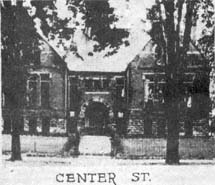
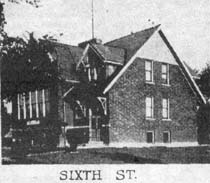
Picture #1 – Union Street School
Picture #2 – Crocker Street School
Picture #3 – Sandusky Street School
Picture #4 – Columbus Avenue School
Picture #5 – Center Street School
Picture #6 – Sixth Street School
Editors Note: To understand how Fostoria’s school system developed, it seems worthwhile to provide a brief historical background, which will serve for future reference, as well as a joyful reminder for those readers who attended the local schools. This series of articles will conclude next week with a bit about teachers, policies and results of education yesteryear and now.
As early as 1832, little provisions for schools had been made for schools in Ohio. The Ordinance of 1785 state, “Religion, morality and knowledge being necessary to good government and the happiness of mankind, schools and the means of education shall forever be encouraged”. Accordingly, the state set apart section 16 in every congressional township, where it had title, for the support of common schools.
The village of Risdon was surveyed and platted August, 1832, by David Risdon for John W. Gorsuch. The village of Rome was surveyed and platted a month later by the same surveyor for Charles W. Foster and John and Roswell Crocker.
Late in 1833 the few early settlers of Rome and vicinity erected a school- house of logs, on a lot at the corner of what later became Poplar and South Streets. The first teacher was Freeman Luce, of Ashland County who was paid $10 and board for 26 days of teaching each month. The people paid the salary on a pro rata basis. This school continued to be used for 12 years. In 1845, a frame schoolhouse was erected to replace the log one.
Edna Hatfield, a long-time resident of Fostoria and teacher in Fostoria schools for 53 years, told me of one incident about the first log school:
“In the early days of Risdon and Rome, there were still Indians in this area, or passing through. They would often stop at the schoolhouse to get a drink of water, so Eliza Davidson, the first teacher, placed a bucket of water at the door so they could help themselves”.
Mrs. Hatfield said the story had been related to her years later, after Miss Davidson married Gideon Jones, one of the early teachers in the Risdon school. They became the grandparents of Dr. Chalmer Hatfield, her husband. I remember Dr. Hatfield as a boy. His home and office was the same location as the present residence of Mrs. Hatfield and her father, Helene, 336 S. Main St.
After the marriage of Eliza to Gideon, she also taught in the Risdon school. In addition to being a teacher, Gideon Jones was a surveyor and laid out Fostoria’s Fountain Cemetery. The Joneses were also the grandparents of Floyd Kinnaman’s father, who with his family were well-known Fostorians many years ago. At one time, when I was a boy, the Kinnaman family resided in the house next to the property presently owned by Arthur Kaubisch on Columbus Avenue.
The early settlers in Risdon did not erect a school building at first. Instead, they held school in private homes until 1837. The first teacher was Marcus Dana, a physician.
The Ohio legislature passed an act in 1837 requiring townships to provide public schools and for schooling at least three months a year.
Since Risdon, in 1837, had not more than 12 school-aged children, and they could not support a school, they were required to utilize a school in an adjoining district which had been erected south of the cemetery.
By 1845, Risdon had grown sufficiently to support their own school, and in the autumn of that year, they erected a frame building in the center of the village, which served their needs for 10 years.
In 1854, when Risdon and Rome united to become Fostoria, an election was held and it was voted to erect a two story brick schoolhouse of four rooms. C.W. Foster donated a lot at the corner of Main and Fremont Streets where the Methodist Church was later located and where Governors Manor now stands. On the first Monday in January, 1856, Fostoria’s first public school opened with John McCauley was principal and Miss Frances Feeble, assistant.
In 1848, the Ohio legislature enacted laws permitting cities and towns to organize one school district within their boundaries. In 1863, Fostoria voted to adopt the new state law, and first elected Board of Education consisted of Edwin Bement, president; J.V. Jones, secretary; and R.C. Caples, Charles Foster, Rev. J.S. Thrapp, and Rev. Levi Moore. The first superintendent of schools hired by the board was C.C. Nestlerode.
The four-room school at Main and Fremont continued to be used, but attendance was low because young men laid aside their school books to rally to their country’s call for army service in the Civil War.
In 1874, the first graduating class consisted of Lucille and Ida Whittaker. That year also saw the building of another school to supplement the school facilities in Fostoria. A two-room brick school was erected on West South Street, in the approximate location of the White Front SuperMarket.
In later years, after the school was no longer used, Jack Wainwright had a printing shop which he and his brother operated. It was an extra activity for them, in addition to teaching instrumental music in the schools.
The schools at Fremont and Main and on South Street comprised the facilities until the “Central” building was completed in 1878.
Fostoria was entering a period of strong growth by 1877, when the population reached approximately 3,500. There were three railroads serving Fostoria; manufacturing was starting; and the school population was increasing. During the remainder of the century, population growth continued, as did school enrollment. By 1900, the population was 8,700 and school enrollment was 1,541…750 boys and 790 girls.
The new Central building provided schooling for grades one, two, three, six, seven, and eight and kindergarten.
The Board of Education was soon faced with the necessity of building more schools to accommodate soaring schools enrollment.
The Center Street School, built in 1890, accommodated grades one through six; Columbus Avenue, built in 1891, had grades one through six, while Union Street, built in 1893, at the corner of Union and Summit, had grades one, two, three, four, five, six, seven and eight.
Rented rooms in the Bond Block, also the Elarton Block provided additional space for grades four and five. Crocker Street School, built in 1901, was used for grades one through six. The Sixth Street school was built in 1908.
During the period when H.L. Ford was superintendent of Fostoria schools (1937 -1962), several new buildings were constructed and old ones demolished. The original building on Sandusky and Columbus Avenue were replaced with new ones. The construction of Holmes, Riley and Lowell provided new and better facilities and their locations were more accessible for the greater school enrollment. The old Union Street building was demolished. The Center Street building was sold to the K of C Lodge for clubrooms.
Only Crocker and Sixth Street, constructed shortly after the turn of the century remained. Then in 1975, Crocker Street school was demolished to make way for a new fire station. Now only Sixth Street school (Field) remains and is in use. It appears certain the Columbus Avenue school (Bryant) will be closed because of busing of pupils and declining enrollment eliminates a need for it.
It is strange how the passing years brought change in man’s plans, thinking and needs. what will be the requirements for school facilities in the next decade or two? The lowered birth rate certainly predicts that the present facilities should be ample. Will the study courses swing to more basics, now being promoted by some? Will some of the “extras” that has grown into the school curriculum be eliminated?
Only time will tell.